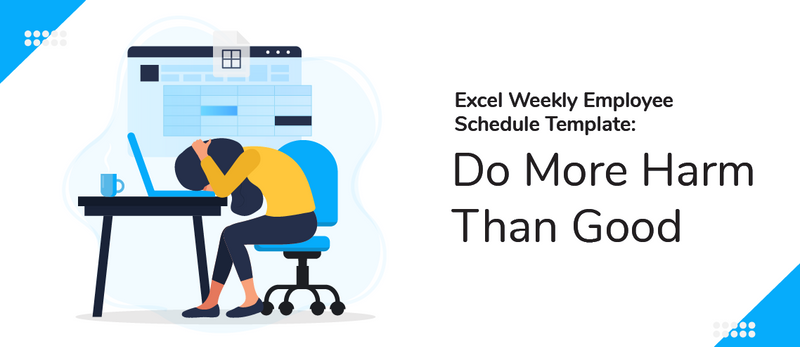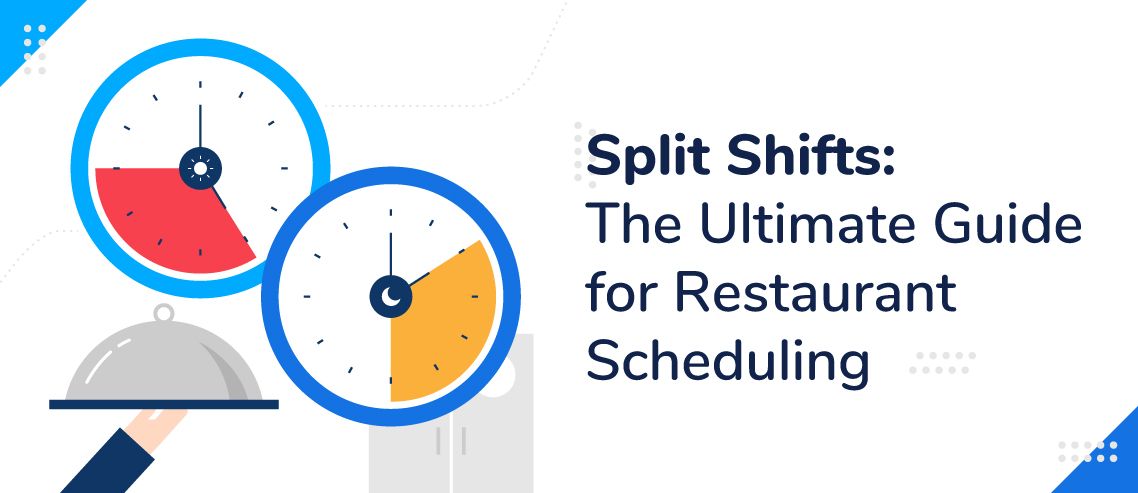Excel Weekly Employee Schedule Template — Do More Harm Than Good

Technology has changed at an exponential rate over the past few years. But despite all the advances in the tech, far too many small business owners have been slow to adopt the new tools and have instead stuck with the outdated, but more familiar, old ones.
And that’s to their own detriment. Investing in a new digital toolbox can help small business owners become significantly more efficient, reduce employee error, and most importantly of all, save time and money.
If you’re still using spreadsheets templates to manage your employee schedules, consider this an intervention. We’re going to tell you why you need to ditch the old and get on with the new employee scheduling software— for your own sake.
The Trouble With Spreadsheets Templates
Spreadsheets are great for a lot of things: performing financial calculations, storing customer data, logging the books you’ve read this year — if it’s got data, spreadsheets are often a good bet.
Like spreadsheets, hammers are great for a lot of things too: banging in nails, removing nails, shaping metal, etc.
But just because a hammer can split lumber doesn’t mean that you shouldn’t get an axe. And just because a toothbrush can scrub the floors clean doesn’t mean you shouldn’t buy a mop.
In short, spreadsheets are great — for some things. But when it comes to employee scheduling, trying to use spreadsheets when there are better options is like trying to clean the floors of your restaurant with a toothbrush because you don’t want to spend the money on or learn how to use a mop.
Here’s why spreadsheet templates do more harm than good.
1. Spreadsheets Make Communication Difficult
So, you’ve spent the past few hours writing up the next week’s schedule on an excel template, and you sent it out in an email to your team. But wait — you just realized you made a mistake and scheduled Michael for 12 pm to 4 pm when you meant to write 12 pm to 5 pm.
If you want to fix that mistake, you’ll have to go back into the same employee schedule template, make the change, export it, and then send it out to everyone again — and also hope that they see the new version and don’t get mixed up.
If any of your team members notice a mistake or need to make a change, you’ll have to do the same thing and send out more new versions of the spreadsheet. Plus, since your team members can’t make any changes themselves, everything needs to go through you first, which can take up a lot of your precious time.
2. They’re Clunky and Cumbersome
Spreadsheets were never designed specifically for scheduling employees, and it shows. Just figuring out how to make a schedule look decent on a spreadsheet can be a journey in and of itself. And when it comes to making changes and updates, things just keep getting worse. Sometimes, making a simple change can mean redoing large sections of the spreadsheet.
3. Spreadsheet Lead to Mistakes
We’ve already discussed how updating a spreadsheet means sending out an entirely new one to your whole team. But what happens when you make several different changes, and you end up with five different versions of the same schedule floating around?
The answer: people start to make mistakes. They show up for the shift that was referenced in version 4 or version 3 by mistake and not the most recent version 5. Or you forgot to include them in the most recent email, and now they’re operating on an older version.
Plus, since everything needs to go through you, if an employee requests some time off, you might give it to them, but then forget to add it into the schedule yourself. Now, you might end up understaffed, when you could have entirely avoided that if you could have just told the employee to update the schedule to make it official.
4. They Waste Your Valuable Time
Sending out emails is a task in itself. And that’s not even taking account of all the changing, exporting, finding the file, attaching, re-exporting, finding it again, re-attaching it, etc. that you have to do with spreadsheets.
If an employee requests some time off, you might need to call up all the team members to see who can fill in — not a great use of your time.
Download the Employee Schedule Template
If frustration is your way of having fun, we’re not going to keep you from your guilty pleasures. Here’s a copy of our weekly employee schedule template. It won’t be as efficient as the scheduling method we’re going to talk about next, but it’s the best you’ll come by as far as spreadsheets go.
How To Efficiently Schedule Employees With the Help Of ZoomShift
Now that we’ve taken a look at the nightmare land of spreadsheets, let’s see what some of the new, schedule-specific tools out there can do to help you.
1. Makes Communication Seamless and Reduces Errors
Remember all those versions of spreadsheets floating around in cyberspace? ZoomShift makes them a thing of the past.
With ZoomShift, all team members have access to the same schedule, which is updated in real-time. Anytime you make a change to the schedule, it’s automatically pushed to the shared version so all of your team members can see it immediately. Plus, everyone always only has access to one schedule, the shared one, so they’ll never get confused about which version to refer to.
The result? You don’t have to keep sending out schedule updates, and your employees don’t have to keep track of the dozens of versions that are popping into their inboxes.

2. Designed From the Ground Up for Scheduling
Spreadsheets are designed to be useful in a lot of different applications, but they aren’t optimized to provide the ideal scheduling experience.
ZoomShift, however, is. It was designed by small business owners who understand the pains of shift scheduling and did their best to fix them.
When you schedule with ZoomShift, you can drag and drop shifts instead of typing everything by hand, you can save and use shift templates so that you don’t have to start from scratch every week, and employees can take care of shift swaps themselves so that you don’t have to get involved.
All in all, ZoomShift is designed to save you time — and that means money too.
3. Keep Track of Your Labor Costs
Everyone wants to make sure their business is running efficiently and they’re not spending more money than they need to. The timesheet app in ZoomShift provides full visibility of labor costs for the day, week, and month so you can keep track of your spending. This will help you make informed decisions on the go.

4. Stops You From Ending Up Short-Staffed
In addition to the basic scheduling features, ZoomShift also has additional views, which allow you to see shifts by location and date. This can help you pick out gaps in staffing, which you can then fill to make sure that all your locations and dates are fully staffed.
5. Makes Shift Covers Easy
When you use a spreadsheet, getting a call from one of your team members asking for time off means that you’re likely going to need to call up all your other employees, coordinate the swap, and then send out a new schedule.
With ZoomShift, the process is a whole lot easier. Managers can give their employees permission to coordinate shift swaps among themselves. That means that employees can post a shift cover request, another team member can accept the request, and with the manager’s approval, ZoomShift will automatically update the schedule for everyone to reflect the change — no calling, manual updates, or emails necessary.


How ZoomShift Employee Scheduling Works
Now that you know the benefits of ZoomShift and how it can save tons of time and money. Let’s see how you can use ZoomShift to schedule your employees. In this three-minute video, we have covered everything you need to know.
To schedule your employees effectively ditch the spreadsheet templates and get started with ZoomShift for free.
Key Takeaways
Spreadsheets are a useful tool, and there are a lot of applications for them. But when it comes to scheduling, there are simply better tools for the job.
Tools like ZoomShift, which are specifically designed to make scheduling as efficient and easy as possible, can help you save time and money, reduce employee errors, and make your life a whole lot easier.
Want to learn more about what ZoomShift can do for your business? Click here to try it out for yourself and take your scheduling to the next level.
JD enjoys teaching people how to use ZoomShift to save time spent on scheduling. He’s curious, likes learning new things everyday and playing the guitar (although it’s a work in progress).



